Twin tweaks to conquer local-democracy deficit
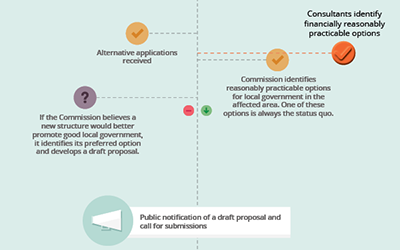

Leak Sinks Secession Hopes: If the motivation for leaking the Morrison Low report was to garner support for the Northern Action Group’s long-running bid for a north-Rodney unitary authority, the headline given it by the Mahurangi Matters has likely scuttled the misguided cause. Messing with local body boundaries invariably proves to be exceedingly disruptive, and seldom, if ever, delivers the long-term financial gains claimed by proponents. The Morrison Low report on the reasonably practicable Auckland reorganisation options, embargoed until today, is now available on the Local Government Commission website. front page piece Mahurangi Matters
Status quo would be the less satisfactory option. Corner to corner, the Rodney Local Board area stretches 86 kilometres—a 165-kilometre, 2-hour drive by road, plus at least an hour’s walk at either end.
In the context of an area of nearly 87 000 hectares, local board is an oxymoron. Nor is there much in the way of community of interest between the northeastern and southwestern halves. One half has a Tasman Sea and Kaipara Harbour coastline, and connects with the city centre via the west; the other half has a predominantly Hauraki Gulf coastline, and connects via the Auckland Harbour Bridge.
So disparate are the areas, that meetings of the Rodney Local Board are held in Ōrewa, which is in neither half. Today, however, the possibly of local government being returned to each area took a step closer, with the release of the Morrison Low report finding that the two-local-board model proposed by Mahurangi Action was the only option suggested, from a provisional shortlist, that met the statutory reasonably-practicable-option test.
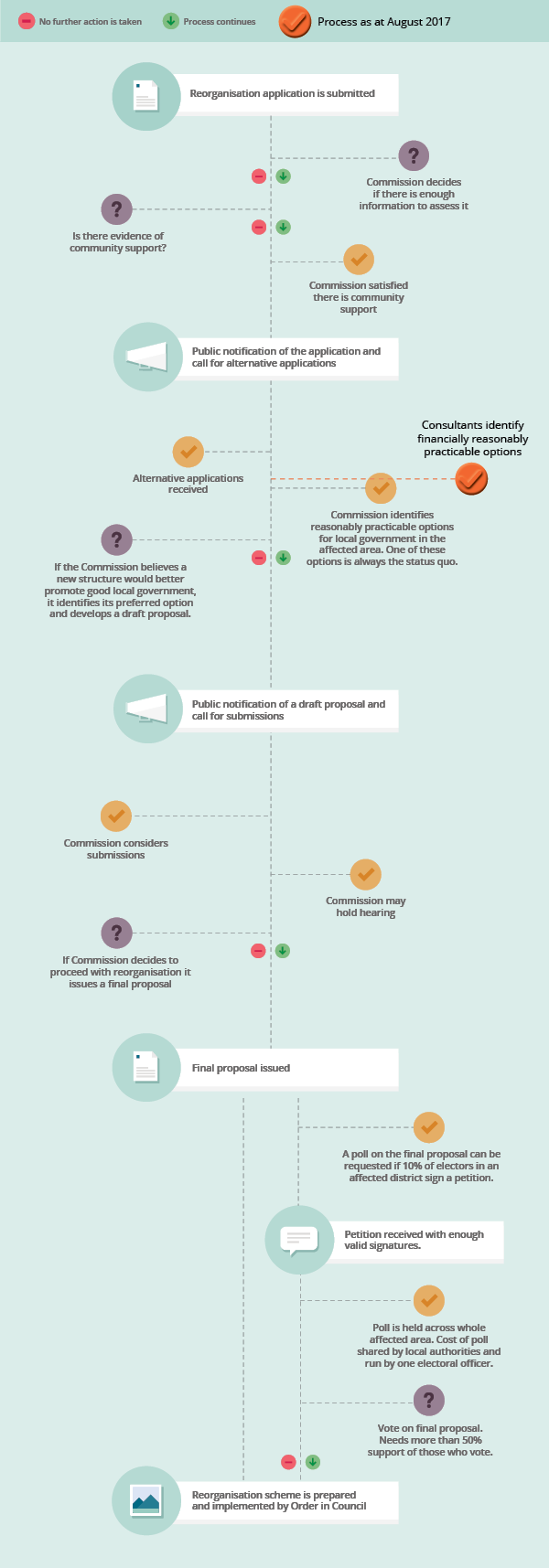
Costly Failure to Heed Hard Lessons: The 2005 bid by Rodney District Council mayor, John Law, to remove Rodney from the Auckland region was binned when it was realised just how costly it would have been for a small unitary authority to meet its statutory obligations. That should have been an end of it, and, 12 years on, with the Morrison Low finding that rates would rise by up to 48%, still leaves a possible further 12 eye-wateringly expensive steps. The twin Rodney local board tweak that is the likely outcome, could have been provided for inexpensively, had the some in the community taken a less dogmatic approach to the governance needs of northeastern Rodney. chart Mahurangi Magazine, adapted from Local Government Commission
The criteria that Morrison Low were asked to assess the Local Government Commission’s provisional shortlist on was that required by law, but excluding the comprise-distinct-communities-of-interest criterion, which the commission will assess in-house. But with the two-local-board model scoring so well, and the other options, such as creating a new unitary authority for the northeastern half of Rodney Local Board area, scoring so abysmally—that option was predicted to raise rates in the area by about half as much again—it is unlikely that the final shortlist will consist of more than two options:
- the status quo, which by law is always an option; or
- two local boards.
It would be a tragedy if, after the millions expended on the issue—$600 000 by the commission alone since 2013—the Local Government Commission saw insufficient benefit in the two-local-board model to recommend other than the status quo. The issue of secession has dogged the district since 2005, when Mayor John Law explored the possibility. Then, Law had the good grace to accept the findings that a change from district council to unitary authority would result in a ruinous rise in rates. This, however, didn’t stop Rodney District Council, just four years later, having another crack, in a bid to escape the reorganisation of Auckland’s one regional and seven city and district councils.
Unfortunately, the arrogance and shortcomings of the Royal Commission on Auckland Governance has left a legacy of resentment—that the ‘super city’ has been imposed upon communities that saw themselves as other than Aucklanders. Unfamiliarity of most citizens to its recommendations means that commissioners have largely escaped culpability. Instead, changes that were made by the National-led government’s Minister of Local Government and Act Party leader, Rodney Hide, are popularly imagined to have caused the deficiencies perceived in the structure implemented, particularly the lack of power and funding for local boards.
In fact, it was the royal commission itself that paid so little mind to the local in local government. It had approached the local government reform from the top, being exceeding enamoured of the London model—the word London appears 83 times in the text; Sydney, 33. The commissioners found the wide range of executive powers wielded by the Mayor of London particularly appealing. They then, somewhat desperately, went on to detail the sterling qualities that the new mayor of Auckland would need to exhibit, as though their divine hand in shaping the perfect governance structure could in any way guarantee that the mayor elected would, for egregious example, refrain from fornicating in the Auckland Town Hall’s Ngāti Whatua Room.
When the commission got around to considering the local representation, as opposed to the regional, it realised that time was running out in which to have its master plan implemented ahead of the 2010 local-body elections. As an expedient to that goal, it recommended that the seven existing city and district councils stay in place, as ‘local councils’, but be stripped of all power and funding except that granted by the governing body of the new Auckland Council. This model could not have been further from the best thinking on the subject, which was provided by the old Auckland City Council. Rather than the provenly problematic notion of pulling the teeth of, and retaining, the old structures, Auckland City Council’s model allowed for a menu of local structures that could be selected for the individual community. Under the proposed model, Wellsford, for example, might have been home to a local council concerned with the geographically extensive area north of the Tamahunga Range.
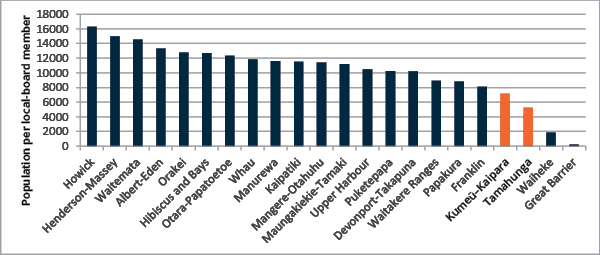
Outlier Islands: Great Barrier and Waiheke islands, understandably, are the outliers in respect to the ratio of population per local-board representative. The Kumeū–Kaipara and Tamahunga local boards, proposed by Mahurangi Action, with five members each, would more closely resemble Franklin Local Board, which has nine members. For reasons unknown, the Local Government Commission asked Morrison Low to model two six-member boards for Rodney, rather than the more obvious number of five—as represented here—including to avoid tied local-board voting. (Great Barrier and Waiheke are both five-member local boards.) chart Mahurangi Magazine, adapted from Auckland Reorganisation Process – Auckland Options Assessment
Local Government Commission | Morrison Low
In the event, the government overrode the royal commission and instructed the Local Government Commission to come up with 20 to 30 local board areas. The commission, fatefully, settled on 21. Thirty would likely have seen a Tamahunga Local Board created, rather than the grotesquely large Rodney Local Board area—the old Rodney District Council, sans the Hibiscus Coast. This was the opposite of what was required to starve the dogged doomed-from-day-one secessionist movement of dog roll. Seven years on, it would be callous of the Local Government Commission to fail to throw the dog a good healthy bone—the two-local-board model, in one form or other.
Regardless, the unitary authority option is almost certainly off the table. Not only is it calculated to hike rates by up to 48% excluding transition costs, which were apparently outside Morrison Low’s brief. Whatever the transition costs might have been, they would have had to have been added to the apparently unknowable transition cost of the Auckland region’s restructuring to date. Any structure can be made to work, as evidenced by Brisbane with its 81 councillors and most of that metropolis under one council, and Sydney with its 411 representatives, spread across 34 assorted shires, councils and other municipalities. What is indispensable is people with the capacity of goodwill and big-picture thinking. Auckland, for better or for worse, having undergone radical reorganisation, now desperately needs to settle down and do the job the restructuring was intended to address: planning and building the infrastructure necessary for the region’s relentless growth.
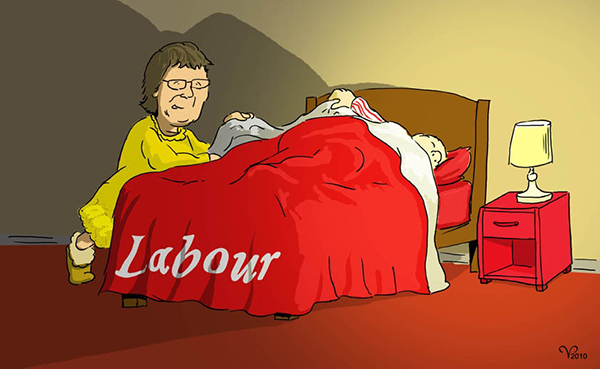
Improbable Paths of Action: The then chairman of the Auckland Regional Council put it better than anyone when he said ‘Rather than serving the best interests of Rodney residents, and ensuring it is best poised to hand over a credible legacy to the new Auckland Council, Rodney continues to pursue improbable paths of action.’ That included ex-ACT mayor of Rodney District Council, Penny Webster, somehow convincing the Labour Party to sponsor a private member’s bill, which of course went precisely nowhere. The equally improbable path of action currently being pursued continues to dog the unfailing efforts of diligent council officers and the community to make the new structure work, for the wellbeing of all citizens of the region. cartoon Majorlook Productions | Mahurangi Magazine
Ironically, that planning, the raison d’être for the restructuring, could be much further advanced if not for the mammoth job of merging one regional and seven city and district council plans into a single unitary plan. Warkworth, having been decreed a satellite growth centre from day one of the new Auckland Council, will belatedly begin the structure plan process for its extensive future-urban zoned land, later this year. The structure-plan process cannot start soon enough, given the pressure being applied by individual developers to pre-empt it, with their own piecemeal schemes. A fivefold increase in population, if left to the proclivities of the developers, would see another 20 000 cars attempting to access the already vehicle-congested town centre. Town planning is expensive, but it makes up a mere 5.5% of operational expenditure. It is the very last place that a metropolis that trebled in population in the last 50 years, and will probably treble again in the next half century, should be economising.
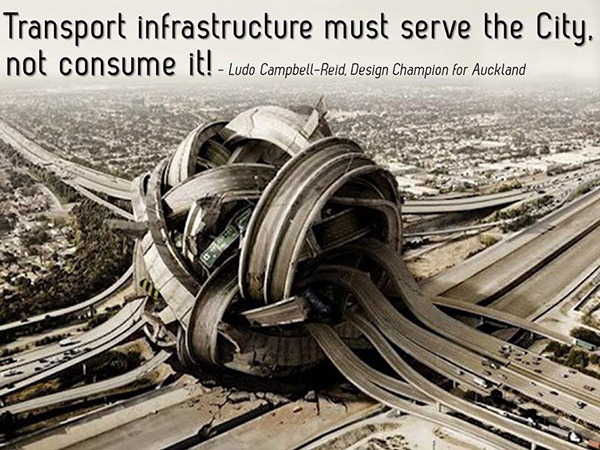
Prone to Repeat the Error: History shows that siting a satellite growth centre on a railway works, but on a motorway doesn’t. Yet somehow, that is exactly what was ordained for Warkworth in 2010, and is now set in the stone of the Auckland Unitary Plan. But rather than repeat the same-old-same-old car-centric disaster, which would terminally gridlock its tidehead town, the community is about to be challenged to picture a walkable town, from which the quickest, cheapest and most comfortable way to reach the city centre is via a community taxibus from the door, and thence by busway. Ludo Campbell-Reid’s Warkworth Town Hall Talk: Friday 15 September, 5 for 5.30 pm graphic @AklDesignChamp
Dick Hubbard’s one-term mayoralty, aside from humbling John Banks, had the very positive benefit of luring Ludo Campbell-Reid from London. In his role as design champion for the Auckland region, and general manager of the Auckland Design Office, Ludo will give the second major Warkworth Town Hall Talk, on 15 September. Ludo is likely to challenge the community to imagine a bold new fit-for-service town, as opposed to a continuation of the urban sprawl Auckland has been sadly synonymous with. Density, paradoxically, allows for more open space—shared open space—and for generous shared cycleways and walkways, and even for dedicated cycleways.
High on the list of criteria for the planning of Mahurangi’s tidehead town as a satellite-growth-centre, must be consideration for the harbour’s elevated sediment accumulation rate. Testimony to the solid work underpinning it, the Auckland Unitary Plan provides for an impressively high level of consideration for freshwater ecosystems. This is typically an anathema to developers, and, in the past, also to their engineers. But by designing and building to a much greater density than old-style single-lot development allowed, streams and ephemeral streams can be respected and incorporated, and celebrated as part of the shared open space to be enjoyed.
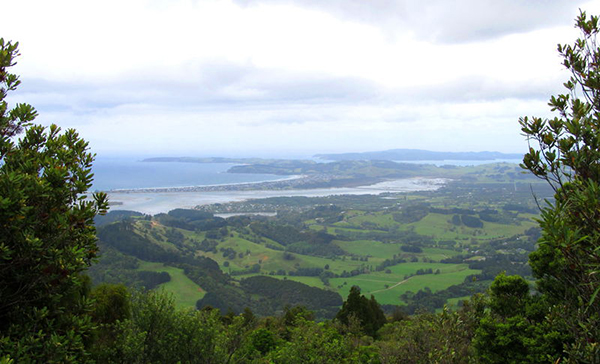
Twin Peaks: The Royal Commission on Auckland Governance, despite purporting to favour Māori names for the local councils in its recommendations, wilfully ignored the geographically obvious replacement for Rodney, from Cape Rodney, from Admiral George Brydges Rodney. The 1st Baron Rodney, like so many whose names adorn the coastline at the expense of te reo, never set foot in Aotearoa. In addition, what the Local Government Commission is referring to as the North Rodney Local Board area includes Kaipara Harbour coastline, which is far removed from Cape Rodney. (Whangateau, Ōmaha, Tawharanui and Kawau, viewed from one of the twin peaks of Mount Tamahunga.) image Ecofest
Good local government requires that those who most familiar with local threats and opportunities—the locals—are involved in the solutions. If a north Rodney local board is created, that does not mean that all decisions about the new town will be made in the Warkworth Town Hall. In a democratic world, there is always a higher authority, no matter how the secessionists crave to be masters of their own destiny. Even in a north Rodney unitary authority, towns such as Pūhoi and Wellsford would not be autonomous. And the unitary authority would have to abide by the government, not least of all the Local Government Commission and the Ministry for the Environment. And in turn, the government is obliged to respect the likes of the International Criminal Court, the United Nations, and, when democracy finally prevails, a United Nations Parliamentary Assembly.
A northeastern local board, or to give it its logical and natural name, Tamahunga Local Board, is a reasonably practicable option. And if it is diligent, and works closely and collaboratively with its community, its advice will be lapped up by Auckland Council’s governing body—it will make the mayor’s and the governing body’s lives that much easier.
Creating twin local boards where there is now one—twin tweaks—is looking increasingly likely.
The one reasonable, reasonably practicable option.
